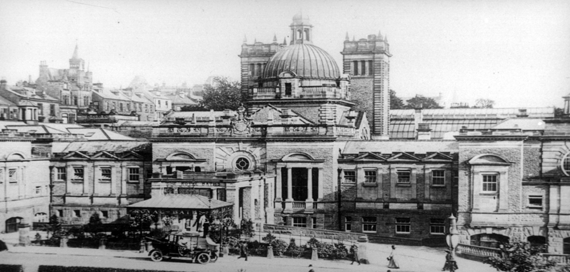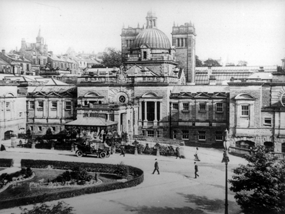History of the Royal Baths, Harrogate

Keith Spence looks at the glittering past of Harrogate’s Royal Baths and senses the excitement as the building enters a new era.
Why go to Turkey if you don’t fancy the flight or the food? Instead, take a trip to Harrogate, where you are guaranteed a full Turkish experience and Chinese food in surroundings that are second to none.
The Harrogate Royal Baths have long been a magnet for the rich and famous. In Victorian times, Royalty would amuse themselves by racing their bathchairs through the Harrogate streets towards the Baths. Princess Alix of Hesse and her sister, Princess Victoria of Battenburg, were regular visitors. Cabinet meetings were sometimes held in the Pump Room with the esteemed enjoying a massage soon after.
 For years, the Royal Baths has been the jewel in the spa’s architectural crown. The venue sits at the bottom of Parliament Street and faces the Crescent Gardens. After years of neglect and dereliction after the rich and famous (and even some down-to-earth Yorkshire folk!) stopped coming to the spa for treatment, the Royal Baths is once more a centre of excellence. Only in a very different form.
For years, the Royal Baths has been the jewel in the spa’s architectural crown. The venue sits at the bottom of Parliament Street and faces the Crescent Gardens. After years of neglect and dereliction after the rich and famous (and even some down-to-earth Yorkshire folk!) stopped coming to the spa for treatment, the Royal Baths is once more a centre of excellence. Only in a very different form.
“Famous mineral waters”
Today the Royal Baths, which originally opened in 1897, is enjoying a renaissance. The Turkish Baths and Health Spa have been extended. Plus, the £1.5m restoration of the Grand Pump Room now houses a Chinese restaurant. The Pump Room of the Royal Baths was originally used to dispense the famous mineral waters to a great octagonal mahogany counter. But the real glory of the 1897 building was the soaring dome. And it was this magnificent architectural feature that meant love at first sight for the site’s restaurateur, Mr Hak Ng.
He explains: “The only reason I’m here is because of the dome. Some people win the lottery, I’ve won this. It’s been a lifelong dream. I wouldn’t have spent £1.5m if it hadn’t been for the dome. I spent one year in China to prepare myself for this building. I’d never been to China before, although I ran a Chinese restaurant in Bedfordshire. I transformed a Co-op mini market into an award-winning restaurant. I’m Chinese; my father moved to Malaysia because of the Communists and I was brought up there. I work from 9 till 2 am seven days a week. I see my wife only occasionally because she runs our Bedfordshire restaurant. I’ve had to close my coffee shop there to concentrate more resources on the Harrogate venture.”
“Wondrous transformation”
Hak and his wife Monica fell in love with the building in 2005. They spotted a gap in the market for a luxury Chinese restaurant in Harrogate. Hak spent his time in China sourcing traditional furniture, crockery and wood carvings. Six containers of furniture were imported, including a 16-person table. It measures five metres long which takes pride of place in the private dining area.
 It took two and half years and £1.5m to complete the refurbishment. This was mainly down to its listed building status and objections from Harrogate Civic Society. Yet, since its completion, the Society has been full of praise for the transformation. “If I’d been able to open the restaurant earlier I’d have become established before the recession kicked in. But then I opened my Bedfordshire restaurant in a recession and it’s been a great success,“ says Hak.
It took two and half years and £1.5m to complete the refurbishment. This was mainly down to its listed building status and objections from Harrogate Civic Society. Yet, since its completion, the Society has been full of praise for the transformation. “If I’d been able to open the restaurant earlier I’d have become established before the recession kicked in. But then I opened my Bedfordshire restaurant in a recession and it’s been a great success,“ says Hak.
Harrogate historian Malcolm Neesam is overwhelmed with the refurbishment. After visiting the restaurant, he said: “What I saw was so magnificent, so glorious that I almost despaired of being able to do justice to its splendid appearance.”
Of the restoration work to the dome, the new floor of glistening marble, the marble memorial plaque, the Harrogate Coat of Arms and the stained glass, Mr Neesam praised the planners and Mr and Mrs Ng for achieving “this wondrous transformation.”
Hak also takes great pride in a letter he has received from Clarendon House. It was from Prince Charles, who was delighted with the restoration.
“International reputation”
 Within the Royal Baths is the world-famous Turkish Baths. Five years ago it also underwent a £1m refurbishment. The plan was to bring them back to their glittering Victorian beginnings. Since then, customer numbers have been increasing. The latest extension – to create two further treatment rooms and bring manicures and pedicures into one suite of rooms – will make sure that demand can be met.
Within the Royal Baths is the world-famous Turkish Baths. Five years ago it also underwent a £1m refurbishment. The plan was to bring them back to their glittering Victorian beginnings. Since then, customer numbers have been increasing. The latest extension – to create two further treatment rooms and bring manicures and pedicures into one suite of rooms – will make sure that demand can be met.
Turkish Baths were common in Victorian times, but only seven remain which date back to the 19th century. Three of the seven, including Harrogate, are in England (the Victorian Health Suite in Carlisle and the Health Hydro in Swindon are the others). But none of them is as historically complete and in full working order as Harrogate’s Turkish Baths. Their importance lies in their decoration, elaboration and rarity.
Harrogate’s forefathers established Turkish Baths for Harrogate in the late nineteenth century as part of the development of the spa town. Their location quickly helped to establish Harrogate’s international reputation, boasting some of the finest spa facilities available.
“Ancient bathing”
The Royal Baths were said to be the most advanced centre for hydrotherapy in the world. The Turkish Baths were only one of many facilities during the Royal Baths’ heyday – also included was a medicinal waters’ dispensary, hydrotherapy departments, mud baths and steam rooms as well as the full complement of consulting doctors. What may seem like a bizarre range of treatments today – including the likes of ‘Plombiere’ douche, Harrogate Hot Water and Galvanism – were familiar practises back then.
The First World War brought social change. Although the number of rich visitors coming to Harrogate to ‘take the waters’ declined, those of middle income increased and the Harrogate spa was the only one in England to make a profit during the inter-war years.
 Turkish Baths, or ‘hammams’ as they are named in Turkey, are used for many aspects of health, not just for external cleanliness. Before Turkey was established as a separate country, the Romans, Byzantines and nomadic peoples had their own variations of bathing rituals. These traditions combined, creating a different variation of these ancient bathing habits – the Turkish Baths.
Turkish Baths, or ‘hammams’ as they are named in Turkey, are used for many aspects of health, not just for external cleanliness. Before Turkey was established as a separate country, the Romans, Byzantines and nomadic peoples had their own variations of bathing rituals. These traditions combined, creating a different variation of these ancient bathing habits – the Turkish Baths.
“Modern treatments”
The Bath’s Moorish design with great Islamic arches and screens, walls of vibrant glazed brickwork, the arabesque painted ceilings and terrazzo floors (laid by the very best Italian experts) all add to its historic fantasy qualities.
With the introduction of the National Health Service, spas in England struggled to remain commercially viable in the 1950s. The decline of spa visiting due to the emergence of modern treatments and technology finally led to the closure of Harrogate’s spa treatment centre in 1969.
This stunning re-development and high quality restaurant, alongside the renewed interest in spa facilities, should ensure the Royal Baths goes on to attract many people – rich, famous or otherwise – far into the 21st century.









